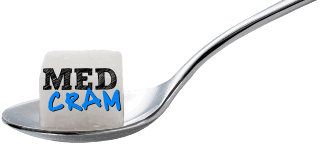In this video, Dr. Seheult of MedCram discusses the burden of sleep apnea and its potential deleterious effects on health. It is a very common disease and often people don’t even know they have it.
What is obstructive sleep apnea?
The problem with obstructive sleep apnea or OSA is primarily a mechanical one. When you go to sleep, your “airway” also goes to sleep in that the airway muscles relax. This allows the tongue to fall back and obstruct the airway preventing oxygen from going in. Part of the brain then which is monitoring oxygen levels notices that the oxygen levels are dropping. It stimulates the entire brain to wake up and awaken the muscles in the neck area to contract and relieve the obstruction and restore airflow. This can causes repetitive waking throughout the night and prevents a restful sleep.
Men vs women and OSA
OSA occurs more often in men than women, but women quickly catch up to that risk after menopause. Typically when men gain weight they tend to store it in the tongue more than women. This causes it to enlarge and makes it more likely to obstruct. Also, men’s airways are larger which make them more prone to collapsing and can contribute to OSA.
Symptoms of OSA
How is sleep apnea often picked up? Snoring is a common factor and/or bed partners witness the individual stops breathing at night. The person may feel tired in the morning or wake up with headaches. However, it can be more subtle such as body aches, low energy, or fibromyalgia.
How to diagnose OSA?
Sleep apnea can be recognized on a polysomnogram which looks at brain waves, oxygen saturation, EKG, thoracic and abdominal movement. On these polysomnographs, you can see the patient having recurrent awakenings. Untreated sleep apnea can lead to increased cardiovascular disease and one analysis showed that people with OSA are more prone to have sudden death from OSA between the hours of 6 am to 12 pm.
How to treat OSA?
There are three different ways of bypassing the obstruction. The most popular way to do this is to wear a cpap mask which allows for a gentle amount of pressure to be placed and keep the airway open. During a sleep study, the cpap pressures are titrated up on an individual basis until the obstructions are alleviated.
Another way is to use an oral appliance to try and pull the lower jaw to which the tongue is attached or just pull the tongue itself forward and keep it from obstructing. This could be done with a mandibular advancement splint or a simple tongue-retaining device. These are typically used in mild to moderate apnea and can’t be used effectively in severe apnea.
The third option is to use a hypoglossal nerve stimulator which is implanted with a lead going to the intercostal muscles and into the neck to stimulate the hypoglossal nerve to move the tongue. This is best indicated in moderate to severe sleep apnea and in those patients that have not been able to tolerate a cpap machine.
Risk factors
Sleep apnea is very common and can have a large impact on your quality of health and can prevent many cardiovascular events.
Risk factors include obesity; however, it can also occur in thin individuals as it is related to the anatomy of the neck, if parents have sleep apnea as this can be genetic, if you are on more than 3 blood pressure meds, atrial fibrillation, recent weight gain over 20 lbs in last six months, and if you find yourself falling asleep frequently. If you have been experiencing any of these issues, please be sure to contact your physician for further evaluation.
LINKS / REFERENCES:
Sleep Apnea Explained Clearly (MedCram) | https://www.medcram.com/courses/sleep…
Stay Tuned for More Updates
Our COVID-19 videos are always available for free (and ad-free) at MedCram.com. In addition, check out our full library of courses and lectures on subjects ranging from Hypertension Explained Clearly to Sleep Apnea Explained Clearly Course and many more!
Meanwhile, you can find all of our COVID-19 videos compiled here.
Visit MedCram.com for updates on Monkeypox virus infectious disease and more.
